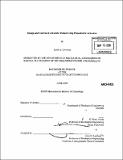Design and control of a robotic thumb using piezoelectric actuators
Author(s)
Levinson, Jacob A
DownloadFull printable version (6.446Mb)
Other Contributors
Massachusetts Institute of Technology. Dept. of Mechanical Engineering.
Advisor
H. Harry Asada.
Terms of use
Metadata
Show full item recordAbstract
Although much more complex and maneuverable than their predecessors, today's anthropomorphic robotic hands still cannot match the dexterity of human hands. While most of these limitations are caused by inadequate sensor and control systems, the use of large, heavy, and stiff actuators can also contribute to dexterity problems. If we expect robotic hands to interact with humans and human objects, joint actuators must allow a compromise of strength and compliance. Piezoelectric (PZT) actuators exhibit a high back driveability which could facilitate this compromise. Although they have low displacement and force output, they are useful in fine control applications. When combined with a DC motor, PZT actuators can produce precise, delicate movements in robotic hands. To develop the novel DC-PZT hybrid system, the force and displacement capabilities of PZT actuators were first characterized with a simple one degree of freedom system. The data from this characterization was analyzed and used to develop a one degree of freedom thumb using a hybrid DC motor/PZT actuator system. To study system performance, a simple position control scheme was implemented for the DC motor and PZT actuators. The experimental results suggest that current PZT actuators, even when combined with a DC motor, cannot produce enough thumb tip force to mirror the functionality of the human hand. That said, improvements to the actuator could make PZT-actuated hands a future possibility.
Description
Thesis (S.B.)--Massachusetts Institute of Technology, Dept. of Mechanical Engineering, 2009. Cataloged from PDF version of thesis. Includes bibliographical references (p. 38).
Date issued
2009Department
Massachusetts Institute of Technology. Department of Mechanical EngineeringPublisher
Massachusetts Institute of Technology
Keywords
Mechanical Engineering.